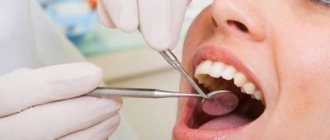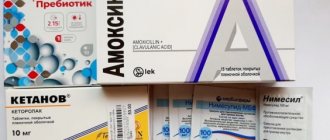When is antibiotic treatment necessary in dentistry?
Most often, antibiotic therapy is prescribed in maxillofacial surgery - as a prophylaxis before surgery and to minimize the risk of complications after it. In dental clinics in Moscow it is indicated for patients:
- with catarrhal gingivitis;
- with periodontitis, in which there is a need for treatment of a dental cyst;
- with advanced periodontitis and periodontal disease;
- with periostitis and osteomyelitis;
- after a complex tooth extraction.
Since the bacterial microflora of the oral cavity is mixed, antibiotics with a wide spectrum of action are prescribed to treat inflammation.
Inflammation of a wisdom tooth
The most problematic for most people are the third molars of the lower dentition, which are commonly called “wisdom teeth.” The upper “eights” relatively rarely become a source of serious problems, but the lower ones are a real headache not only for people, but also for dentists. Their correct treatment or removal requires the doctor to have a lot of experience, skill and, to some extent, wisdom, which once again confirms the accuracy of the popular name for eights.
Lower third molars: history of the problem
Why are the third lower molars so problematic, why does inflammation of the gums near the wisdom tooth occur in almost every second inhabitant of the planet? This is our payment for a comfortable lifestyle, in particular, for changed eating habits. Modern food is very different from what our ancestors ate even a few hundred years ago. Heat treatment made the food soft, making long chewing unnecessary. Children often swallow food without chewing it properly.
What is the result? As a result, the lower jaw does less work, and for the body this becomes a signal that its development can be slowed down, because there is no need for a massive mandibular bone. As a result, it becomes smaller than nature intended. The number eight, which is the last to erupt, has no room left for normal growth and development. Hence the typical problems - retention, dystopia, gum inflammation, almost inevitable pain during teething.
Alarming symptoms
The eruption of the figure eight is often accompanied by pain. But what exactly does a person hurt? Dental tissue, gums near the wisdom tooth, bone tissue of the lower jaw? Or do neighboring elements of the dentition hurt, on which the problematic third molar puts pressure?
The gums near the wisdom tooth hurt. The area of gum that covers the third molar has its own name. It is commonly called the gingival hood. Very often the molar cannot overcome the resistance of the hood and a problem arises. The wisdom tooth does not fully erupt (in this case it is called impacted), and the gums above it become inflamed. Inflammation of the gums near the wisdom tooth is called pericoronitis.
Pain is the first and main symptom of inflammation, but it is far from the only one. In many patients, the gums become swollen, and along with it, the nearby soft tissues of the cheek swell. As a result, the entire middle third of the face on the side of inflammation becomes swollen. Pain often occurs when swallowing and chewing food.
Redness of the gums is another clinical sign that unmistakably indicates the development of an inflammatory process. If you wait too long to seek help from a specialist, purulent inflammation develops, which indicates an infection. Discharge of pus from under the gingival hood and bad breath are symptoms of a purulent-inflammatory process. In the future, the infection can spread to neighboring tissues, including the jawbone.
Treatment Options
If your gums near your wisdom tooth are inflamed, it is better to immediately contact the nearest dental clinic or medical center where you will receive the necessary assistance. The first step should be x-ray diagnosis. If your dentist plans to treat you without an x-ray, consult another specialist.
An x-ray will show exactly how the third molar is growing and erupting. If it grows at an angle in the direction of the second molar, if it “lies” and literally crashes into the adjacent element of the dentition, it needs to be removed. Otherwise, there is a high probability of developing malocclusion, destruction of enamel and carious lesions of the second molar, as well as other problems with the lower dentition and the dental system as a whole.
It should be said that the situation described above with dystopia (abnormal position and direction of growth) is not uncommon. Dystopia of the figure eight occurs very often. If left unattended, sooner or later it will lead to other more serious problems requiring expensive, lengthy and tedious dental treatment.
Is it possible to do without deletion? Certainly. If the molar is growing in the right direction and is not pressing on its neighbor, there is no need for extraction. In this case, the dentist will choose the following algorithm of actions:
- Prescribe anti-inflammatory drugs, painkillers and antihistamines to reduce gum swelling.
- The area of gum above the figure eight is removed to facilitate its eruption. Important! Removal is possible only if there is no infection.
- With the development of a purulent-inflammatory process, antibiotics are prescribed.
- In case of infection, the gingival hood is not removed, but dissected to improve the outflow of pus. After suppressing the pathogenic flora, gum excision is performed.
The cost of therapeutic treatment of gum inflammation near a wisdom tooth is low - about 2,500 rubles. Hood dissection is a painless procedure performed using local anesthetics. After a visit to the dentist, it is enough to follow his recommendations: take medications prescribed by the doctor, regularly rinse your mouth with antiseptic solutions, apply dental gels with anti-inflammatory and antibacterial effects to the inflamed area of the gums.
Wisdom tooth removal
If the position and direction of growth are abnormal, removal of the third molar is indicated. Since it is a vestigial organ, its absence will not in any way affect the function of the dental system, while abnormal growth can lead to malocclusion and other serious problems.
Removing a wisdom tooth is a complex procedure. The figure eight has a powerful root system and is firmly anchored in the jaw bone. The roots are often curved, making the extraction process more difficult. However, dentists have an expression that a good doctor turns a complex extraction into an easy procedure for the patient, but an inexperienced dentist makes a simple extraction difficult and painful. It is very important to contact a qualified specialist!
The presence of a well-developed root system requires special preparation for removal. It involves drilling or crushing the area of bone that holds the roots. A good tactic is sawing the crown; fragments are much easier to remove than the entire tooth.
The cost of complex extraction of impacted and dystopic wisdom teeth varies from 6 to 12 thousand rubles. This price includes anesthesia benefits. The procedure is performed under conduction or infiltration anesthesia; most often, local anesthetics based on articaine (Ultracaine, Ubistezin) are used for these purposes. The extraction lasts 15-20 minutes, but if the doctor does not have the proper experience, the process can even take a couple of hours.
Is it painful to have a third molar removed? According to most patients, it is a little scary, but not painful at all. Psychological discomfort, of course, is present, but there is no pain. Patients who are terrified of dental procedures may be offered sedation or anesthesia, but this is extremely rarely necessary.
After removal
After the procedure, you must follow a few simple rules. First, you should abstain from eating for three or four hours. Smokers must abstain from smoking during this time. You can drink water within an hour and a half after the operation.
In the future, you need to eat soft food for one or two days. Food should not be hot or cold, ideally its temperature should be close to body temperature. Chew food on the healthy side to avoid washing out the blood clot. Formation of a blood clot in the socket is an important part of the healing process. To speed up the healing dynamics, ask your dentist to place one or two sutures on the gum above the hole before extraction. It doesn't hurt, but it's very effective.
Pain after removal cannot be completely avoided; it will make itself felt after the anesthetic wears off. Fortunately, postoperative pain is not severe and can be easily relieved with conventional analgesics. Doctors often prescribe Ketanov or its analogues in injection form to patients. Antibiotics are prescribed to prevent infection; this is especially true in the presence of a purulent-inflammatory process.
Regular rinsing with antiseptic solutions will help suppress the vital activity of pathogenic microflora. Chlorhexidine, which is sold in any pharmacy, is well suited for these purposes. Gels or creams with anti-inflammatory and antibacterial effects should also be applied to the surface of the gums. Please note that you need to rinse your mouth carefully so as not to provoke the blood clot to be washed out of the hole. The procedure is more similar to baths than to the usual rinses.
The body temperature remains elevated after removal. A normal reaction to surgery is weakness and general malaise. There is no need to worry about minor bleeding from the wound. After three to five days, the condition returns to normal, the bleeding stops, and the pain no longer bothers you.
You can learn more about the treatment of inflammation of the gums near the wisdom tooth by consulting a medical dentist.
What are the dangers of taking medications on your own?
The need for antibiotic therapy is determined by the nature of the disease and the body’s response to it. Selectivity in its appointment is explained by two reasons.
- Antibiotics affect all types of microflora, both harmful and beneficial, which in some cases can lead to problems with the mucous membranes of other organs and exacerbation of chronic diseases.
- When exposed to them, bacteria begin to mutate, forming resistance to drugs of a certain type. For this reason, first-generation drugs, such as penicillin, have already ceased to act on pathogens. Scientists have proposed new developments, but if used thoughtlessly, without following the rules of therapy, history may repeat itself.
In addition, each of the drugs has its own side effects - from nausea and itching to anaphylactic shock. Their manifestations may require immediate medical attention.
Therefore, dentists prescribe a course of antibiotics only in cases where the likelihood of complications of the disease exceeds the risks of taking the drug. At the same time, they consciously approach the choice of medication and its dosage, as well as the duration of the course. Let's look at what can lead to self-prescription of an antibiotic for tooth root inflammation.
Inflammation of the gums: causes, symptoms, treatment and prevention
Traditional methods of combating gum inflammation
To combat inflammation and pain at home, there is a wide range of medicinal plants.
The effectiveness of recipes has been tested for centuries. However, as is the case with the use of products sold in pharmacies, to achieve the desired result and to avoid side effects, it is recommended to first consult a dentist. Most folk remedies are decoctions, tinctures and compresses. Among the most popular plants it is worth highlighting the following:
- Oak bark, St. John's wort - produce a general strengthening effect.
- Chamomile, calendula - produce a pronounced antibacterial effect.
- Sage, aloe leaves, yarrow herb - relieve inflammation and relieve pain.
In most cases, plants and herbs are used at first, when gingivitis has not yet caused complications. If they occur, then it is more advisable to use medications. It is better to prepare products in small portions (several times), as they quickly deteriorate. Below we present to your attention several simple and proven recipes.
Recipe No. 1: aloe compress
Aloe leaves have disinfectant and antiseptic properties. The compress is prepared as follows:
- Take a fresh leaf of the plant.
- Remove the spines and outer shell from it.
- Cut lengthwise.
- Apply to the place where the gum is inflamed.
- Hold for 10 – 15 minutes.
The compress is recommended to be used in the morning and evening. To achieve a more effective elimination of inflammation, you can make a concentrated infusion of the juice in boiling water and use it for rinsing.
Recipe No. 2: oak bark decoction
Oak bark perfectly fights bacteria and eliminates inflammation. To make a decoction, you will need 2 tbsp. l. crushed raw materials and 0.5 liters of water. Boil over low heat for 10 - 15 minutes and use daily as a rinse until the condition of the gums returns to normal.
Recipe No. 3: sea buckthorn oil compress
Sea buckthorn oil is commercially available, but it can also be prepared at home:
- Take 1 kg of sea buckthorn berries.
- Extract the juice using a juicer.
- Place in a dark place for several days.
- Use a spoon to remove any floating oil from the surface.
Sea buckthorn oil compresses are effective in treating any inflammatory processes. It’s easy to use: soak gauze in the raw material and apply to the site of inflammation for 15 – 20 minutes.
Recipe No. 4: decoction of pine buds
A good remedy for bleeding gums. All you need is 2 tbsp. l. young kidneys and 500 grams of water. Simmer for 10 minutes, then cool and filter. Rinse your mouth for 5 – 10 minutes.
Recipe No. 5: propolis infusion
Propolis is excellent for restoring tissue joints and has antibacterial properties. To prepare, you need to place the raw material in a dark bottle and fill it with a 70% alcohol solution so that it covers the propolis by about 1 cm. After a day, you need to strain and mix 20 drops of the tincture with 200 grams of water (for 1 procedure). Rinse three times a day.










